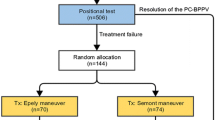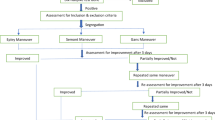Abstract
The aim was to compare the effectiveness of Brandt-Daroff, Semont and Epley maneuver in BPPV resolution. A Single Blind RCT in a Secondary Care Center was performed. Inclusion criteria were: patients with unilateral rotatory nystagmus on Dix-Hallpike Maneuver (DHM). Exclusion criteria: other causes of peripheral or central vertigo. Patients were randomized into 4 groups: Brandt-Daroff, “sham”, Semont and Epley. Patients underwent allocation, 1st visit (at 1 week with reprise of original maneuver if persistent nystagmus) and 2nd visit (2 to 4 weeks) with repetitions of both DHM and DHI. Main Outcome Measures: Absence of nystagmus on DHM at 1st and 2nd visit evaluations and DHI score. Resolution was defined as the abscence of nystagmus. We included 34 patients (25 females, 9 males). Patients were randomized to Brandt-Daroff (n = 9), “sham” (n = 7), Semont (n = 9) and Epley (n = 9) group. Overall mean age was 59.85 years (SD ± 13.10). A total of 47.06% patients (n = 16) had negative DHM at 1st visit. Resolution for Brandt-Daroff was 22.22%, “sham” 28.57%, Semont 44.44% and Epley 88.88% (p = 0.024); at 2nd visit follow up, Epley achieved 100% resolution (other maneuvers: 42.86%, 16.67%, 44.44%, respectively. P = 0.006). The DHI improvement at 2nd visit for Brandt-Daroff was 21.17 points, “sham” 8.05, Semont 14.67 and Epley 61.78 (p = 0.001). Epley maneuver was superior to Brandt Daroff, “sham” and Semont maneuvers on nystagmus resolution and DHI improvement in patients with BPPV.


Similar content being viewed by others


Data Availability
Available upon request.
Code Availability
SPSS was used.
References
Imai T, Takeda N, Ikezono T, Shigeno K, Asai M, Watanabe Y et al (2017) Classification, diagnostic criteria and management of benign paroxysmal positional vertigo. Auris Nasus Larynx 44:1–6
Bárány R (1923) Disease of the Otolith Apparatus. J Nerv Ment Dis 57(1): 70. https://journals.lww.com/jonmd/Citation/1923/01000/Disease_of_the_Otolith_Apparatus.74.aspx
Dix M, Hallpike C (1952) The pathology, symptomatology and diagnosis of certain common disorders of the vestibular system. Proc R Soc Med 45:341–354
Liu Y, Wang W, Zhang A, Bai X, Zhang S (2016) Epley and Semont Maneuvers for posterior canal benign paroxysmal positional vertigo: a network meta-analysis. Laryngoscope 126:951–955
Patangay KK, Ansari R (2016) Benign paroxysmal positional vertigo: our experience. Indian J Otolaryngol Head Neck Surg 68:39–41
Oh SY, Kim JS, Choi KD, Park JY, Jeong SH, Lee SH et al (2017) Switch to Semont maneuver is no better than repetition of Epley maneuver in treating refractory BPPV. J Neurol 264:1892–1998
Oliveira AK, Suzuki FA, Boari L (2015) Is it important to repeat the positioning maneuver after the treatment for benign paroxysmal positional vertigo? Braz J Otorhinolaryngol 81:197–201
Pérez-Vázquez P, Franco-Gutiérrez V, Soto-Varela A, Amor-Dorado JC, Martín-Sanz E, Oliva-Domínguez M et al (2017) Practice guidelines for the diagnosis and management of benign paroxysmal positional vertigo otoneurology committee of spanish otorhinolaryngology and head and neck surgery consensus document [In Spanish]. Acta Otorrinolaringol Esp 69:345–366
Von Brevern M, Bertholon P, Brandt T, Fife T, Imai T, Nuti D et al (2017) Benign paroxysmal positional vertigo: diagnostic criteria. Consensus document of the committee for the classification of vestibular disorders of the bárány society [In Spanish]. Acta Otorrinolaringol Esp 68:349–360
Cetin YS, Ozmen OA, Demir UL, Kasapoglu F, Basut O, Coskun H (2018) Comparison of the effectiveness of Brandt-Daroff Vestibular training and Epley Canalith repositioning maneuver in benign Paroxysmal positional vertigo long term result: A randomized prospective clinical trial. Pak J Med Sci 34:558–563
Jacobson GP, Newman CW (1990) The development of the dizziness handicap inventory. Arch Otolaryngol Head Neck Surg 116:424–427
Ceballos LR, Vargas AM (2004) Application and utility of the Dizziness Handicap Inventory in patients with vertigo from the Otolaryngology Service of the Specialties Hospital of the National Medical Center XXI Century [In Spanish]. An Med Asoc Med Hosp ABC 49:176–183
Brandt T, Daroff RB (1980) Physical therapy for benign paroxysmal positional vertigo. Arch Otolaryngol 106:484–485
Yorker A, Ward I, Vora S, Combs S, Keller-Johnson T (2013) Measurement characteristics and clinical utility of the dizziness handicap inventory among individuals with vestibular disorders. Arch Phys Med Rehab 94:2313–2314
Hilton MP, Pinder MK. The Epley (canalith repositioning) maneuver for benign paroxysmal positional vertigo (Review). Cochrane Database Syst Rev 2014; 12: CD003162.
Lee JD, Shim DB, Park HJ, Song CI, Kim MB, Kim CH et al (2014) A multicenter randomized double-blind study: comparison of the epley, semont, and “sham” maneuvers for the treatment of posterior canal benign paroxysmal positional vertigo. Audiol Neurootol 19:336–341
Gupta AK, Sharman KG, Sharma P (2018) Effect of epley, semont maneuvers and brandt-daroff exercise on quality of life in patients with posterior semicircular canal benign paroxysmal positional vertigo (PSCBPPV). Indian J Otolaryngol Head Neck Surg 71:99–103
Sen K, Sarkar A, Raghavan A (2016) Comparative efficacy of Epley and Semont maneuver in benign paroxysmal positional vertigo: A prospective randomized double-blind study. Astrocyte 3:96–99
Ajayan PV, Aleena PF, Jacobo AM (2017) Epley’s maneuver versus Semont’s maneuver in treatment of posterior canal benign positional paroxysmal vertigo. Int J Res Med Sci 5:2854–2860
Zhang X, Qian X, Lu L, Chen J, Liu J, Lin C et al (2016) Effects of Semont maneuver on benign paroxysmal positional vertigo: a meta-analysis. Acta Otolaryngol 137:63–70
Benito-Orejas JI, Poncela-Blanco M, Díez-González L, Álvarez-Otero R, Aguilera-Aguilera G, Intraprendente-Martini JF et al (2017) Practice guideline for benign paroxysmal positional vertigo [In Spanish]. Revista ORL 8:157–196
Anagnostou E, Stamboulis E, Kararizou E (2014) Canal conversion after repositioning procedures: comparison of Semont and Epley maneuver. J Neuro 261:866–869
Kinne BL, Perla MJ, Weber DT (2016) Semont maneuver versuss Epley maneuver for canalithiasis of the posterior semicircular canal: a systematic review. Phys Ther Rev 21(2):102–108
Radtke A, von Brevern M, Tiel-Wilck K, Mainz-Perchalla A, Neuhauser H, Lempert T (2004) Self-treatment of benign paroxysmal positional vertigo Semont maneuver vs Epley procedure. Neurology 63:150–152
Emad MA, Radwa MY (2017) Effect of Epley maneuver versus Semont maneuver on vertigo in post-menopausal women. Int J Rehabil Res 6:1–4
Van De Wyngaerde KM, Lee MK, Jacobson GP, Pasupathy K, Romero-Brufau S, McCaslin DL (2019) The component structure of the dizziness handicap inventory (DHI). Otol Neurotol 40:1217–1223
Rodrigues DL, de Oliveira CAP, Pires de Oliveira CA, Bahmad F Jr (2019) Effect of vestibular exercises associated with repositioning maneuvers in patients with benign paroxysmal positional vertigo: a randomized controlled clinical trial. Otol Neurotol 40:824–829
Sreenivas V, Natashya S, Sumy P. The Role of Comorbidities in Benign Paroxysmal Positional Vertigo. Ear Nose Throat J 2019.
Talaat HS, Abuhadied G, Talaat AS, Abdelaal MS (2014) Low bone mineral density and vitamin D deficiency in patients with benign positional paroxysmal vertigo. Eur Arch Otorhinolaryngol 272:2249–2253
Byun H, Chung JH, Lee SH, Park CW, Kim EM, Kim I (2019) Increased risk of benign paroxysmal positional vertigo in osteoporosis: a nationwide population-based cohort study. Sci Rep 9:3469
He LL, Li XY, Ho MM, Li XQ (2019) Association between bone mineral density and benign paroxysmal positional vertigo: a meta-analysis. Eur Arch Otorhinolaryngol 276:1561–1571
Acknowledgements
We would like to thank the department of Otolaryngology of CIDOCS and Autonomous University of Sinaloa.
Funding
Part of this study’s data was a poster presentation at the American Academy of Otolaryngology, 2015.
Author information
Authors and Affiliations
Contributions
All authors contributed to the manuscript and are accountable of all aspects of the manuscript.
Corresponding author
Ethics declarations
Conflict of interest
The authors declares that they have no conflict of interests.
Ethics Approval
Research and ethical approval was obtained in CIDOCS, number 0126.
Consent to Participate
All subjects signed informed consent.
Consent for Publication
this study is not considered for publication in any other journal. The submitted work is original and the authors consent to be considered for publication in the indian journal of otolaryngology.
Additional information
Publisher's Note
Springer Nature remains neutral with regard to jurisdictional claims in published maps and institutional affiliations.
Rights and permissions
About this article
Cite this article
Celis-Aguilar, E., Mayoral-Flores, H.O., Torrontegui-Zazueta, L.A. et al. Effectiveness of Brandt Daroff, Semont and Epley maneuvers in the treatment of Benign Paroxysmal Positional Vertigo: A Randomized Controlled Clinical Trial. Indian J Otolaryngol Head Neck Surg 74, 314–321 (2022). https://doi.org/10.1007/s12070-021-02516-w
Received:
Accepted:
Published:
Issue Date:
DOI: https://doi.org/10.1007/s12070-021-02516-w


